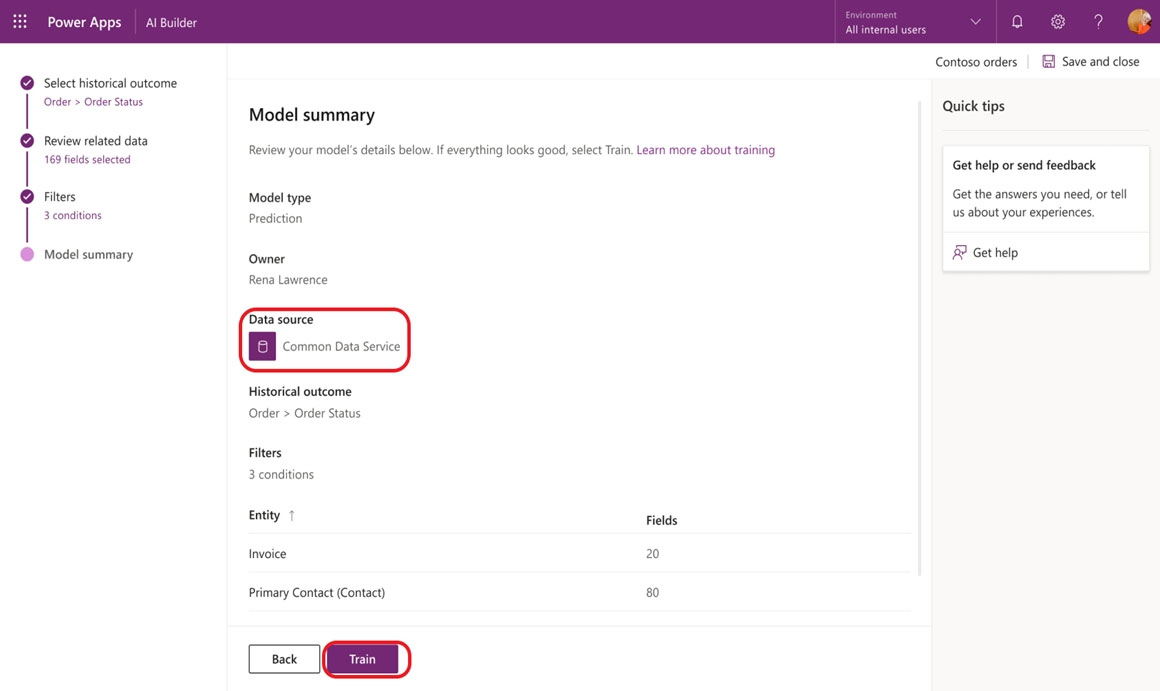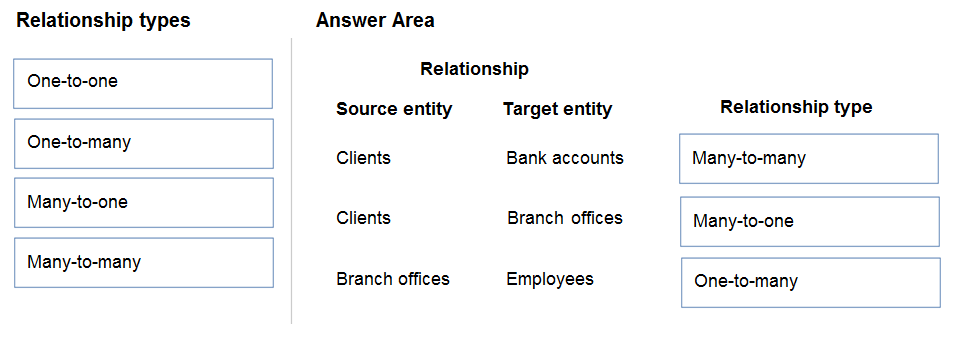DRAG DROP -
A company uses Power Automate and Power Apps to streamline business processes.
You need to use AI Builder to analyze customer reviews of the company's products.
In which order should you perform the actions? To answer, move all actions from the list of actions to the answer area and arrange them in the correct order.
Select and Place:
Answer:

Step 1: Connect data to the model.
First create an AI Builder form processing model for the customer reviews you want to process.
Step 2: Train the model.
Step 3: Publish the model.
Step 4: Use the model in a Power Automate flow.
Once you train and publish the model, create a solution-aware flow in Power Automate.
Reference:
https://powerapps.microsoft.com/en-us/blog/introducing-simplified-ai-builder-experience-in-power-automate/
You are creating a multi-page canvas app that loads tabular data from an external data source.
Once loaded, the data must be available to all screens within the canvas app.
You need to reduce the number of times that the app must retrieve data from the data source.
Which two data stores can you use? Each correct answer presents a complete solution.
NOTE: Each correct selection is worth one point.
Answer:
CD
C: A special kind of data source is the Collection, which is local to the app and not backed by a connection to a service in the cloud, so the information can not be shared across devices for the same user or between users. Collections can be loaded and saved locally.
D: Don't use environment variables if you only have one environment. Use collection variables. Having a single environment connected to the collection creates more overhead.
Reference:
https://docs.microsoft.com/en-us/powerapps/maker/canvas-apps/working-with-data-sources
You are creating a model-driven app that allows users to create and edit a list of existing accounts.
You need to display a list of all active accounts.
Which user interface components should you use?
Answer:
A
With Power Apps apps, use views to define how a list of rows for a specific table is displayed in the application.
Reference:
https://docs.microsoft.com/en-us/powerapps/maker/model-driven-apps/create-edit-views
DRAG DROP -
You create multiple apps as part of an unmanaged solution.
You need to move the apps to a non-managed environment.
You need to pick the appropriate solution type for each requirement.
Which types of solutions should you create? To answer, drag the appropriate solution types to the correct requirements. Each solution type may be used once, more than once, or not at all. You may need to drag the split bar between panes or scroll to view content.
NOTE: Each correct selection is worth one point.
Select and Place:
Answer:

Box 1: Unmanaged -
Unmanaged Solution: The beginning state of solution is the unmanaged solution state. During this phase, you can add, edit, update, remove, delete, and test any of the components of the solution.
Box 2: Unmanaged -
Box 3: Managed -
Managed Solution: A managed solution is a finalized solution that can be distributed and installed. They are created by exporting an unmanaged solution by setting restrictions to prevent any further customizations. The whole point of Managed is locking down the Component states so they cannot be edited. Deleting the Managed Solution will remove all its customisations as well as data contained. Managed Solutions become read only once deployed so they cannot be manipulated.
Reference:
https://powerusers.microsoft.com/t5/Power-Apps-Pro-Dev-ISV/Managed-vs-Unmanaged/td-p/495685
Each maker at a company has a separate Common Data Service environment. You are customizing a canvas app. You create two new entities in your environment.
You are leaving for a vacation. Another maker will continue customizing the app in your absence.
You need to transfer the work to the other maker and ensure that you can work on the updated app when you return from your vacation.
What should you export?
Answer:
A
Unmanaged Solution: The beginning state of solution is the unmanaged solution state. During this phase, you can add, edit, update, remove, delete, and test any of the components of the solution.
Incorrect Answers:
C: Managed Solution: A managed solution is a finalized solution that can be distributed and installed. They are created by exporting an unmanaged solution by setting restrictions to prevent any further customizations. The whole point of Managed is locking down the Component states so they cannot be edited. Deleting the Managed Solution will remove all its customisations as well as data contained. Managed Solutions become read only once deployed so they cannot be manipulated.
Reference:
https://powerusers.microsoft.com/t5/Power-Apps-Pro-Dev-ISV/Managed-vs-Unmanaged/td-p/495685
DRAG DROP -
You are designing a canvas app that will be used by all users including users who have vision impairments.
Which outcome is achieved by each action? To answer, drag the appropriate outcomes to the correct actions. Each outcome may be used once, more than once, or not at all. You may need to drag the split bar between panes or scroll to view content.
NOTE: Each correct selection is worth one point.
Select and Place:
Answer:

Reference:
https://docs.microsoft.com/sv-se/powerapps/maker/canvas-apps/accessible-apps
Note: This question is part of a series of questions that present the same scenario. Each question in the series contains a unique solution that might meet the stated goals. Some question sets might have more than one correct solution, while others might not have a correct solution.
After you answer a question in this section, you will NOT be able to return to it. As a result, these questions will not appear in the review screen.
You build a canvas app for a manufacturing company. The company receives parts and materials from many vendors. You create a form to collect information from packing slips.
Receivers must be able to take a picture of packing slips to receive materials instead of manually entering data in the app.
You need to ensure that users can scan packing slip information into the form.
Proposed solution: Use a Category classification model.
Does the solution meet the goal?
Answer:
B
A Category classification model categorizes text by its meaning.
Reference:
https://knowledgefrommanish.com/powerplatform/ai-builder-entity-extraction-ai-model/
Note: This question is part of a series of questions that present the same scenario. Each question in the series contains a unique solution that might meet the stated goals. Some question sets might have more than one correct solution, while others might not have a correct solution.
After you answer a question in this section, you will NOT be able to return to it. As a result, these questions will not appear in the review screen.
You build a canvas app for a manufacturing company. The company receives parts and materials from many vendors. You create a form to collect information from packing slips.
Receivers must be able to take a picture of packing slips to receive materials instead of manually entering data in the app.
You need to ensure that users can scan packing slip information into the form.
Proposed solution: Use an Entity Extraction model.
Does the solution meet the goal?
Answer:
B
Instead use the Use a Text Recognition model.
Note: Create a canvas app and add the text recognizer AI Builder component to your screen. This component takes a photo or loads an image from the local device, and then processes it to detect and extract text based on the text recognition prebuilt model. If it detects text in the image, the component outputs the text and identifies the instances by showing a rectangle for each instance in the image.
Incorrect Answers:
AI Builder entity extraction models recognize specific data in the text that you target based on your business needs.
The model identifies key elements in the text and then classifies them into predefined categories. This can help you transform unstructured data into structured data that's machine-readable. You can then apply processing to retrieve information, extract facts, and answer questions.
Reference:
https://knowledgefrommanish.com/powerplatform/ai-builder-entity-extraction-ai-model/ https://docs.microsoft.com/en-us/ai-builder/prebuilt-text-recognizer-component-in-powerapps
Note: This question is part of a series of questions that present the same scenario. Each question in the series contains a unique solution that might meet the stated goals. Some question sets might have more than one correct solution, while others might not have a correct solution.
After you answer a question in this section, you will NOT be able to return to it. As a result, these questions will not appear in the review screen.
You build a canvas app for a manufacturing company. The company receives parts and materials from many vendors. You create a form to collect information from packing slips.
Receivers must be able to take a picture of packing slips to receive materials instead of manually entering data in the app.
You need to ensure that users can scan packing slip information into the form.
Proposed solution: Use a Key Phrase Extraction model.
Does the solution meet the goal?
Answer:
B
The key phrase extraction prebuilt model identifies the main points in a text document.
Reference:
https://docs.microsoft.com/en-us/ai-builder/prebuilt-key-phrase
DRAG DROP -
You are designing an app for a bank. You plan to use the following entities in the app:
You need to configure the relationships between the entities.
Which relationship types should you use? To answer, drag the appropriate relationship types to the correct relationships. Each source may be used once, more than once, or not at all. You may need to drag the split bar between panes or scroll to view content.
NOTE: Each correct selection is worth one point.
Select and Place:
Answer:

Box 1: Many-to-many -
Box 2: Many-to-one -
A client have a single branch office.
A branch office can have many clients.
Box 3: One-to-many -
A branch office can have many employees.
An employee only works at one branch office.